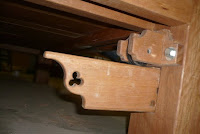Tools
You can't have a wood show without tools, and there certainly was a lot of them. Traditional hand tools, power tools, tools for woodworking, tools for tradies, machinery, and milling equipment were all on display. Here are some that caught my eye.
Torque Work Centre
The Torque Work Centre (www.torqueworkcentre.com) is a Queensland built precision mounting platform for traditionally hand held tools (eg. drills, routers, and circular saws). It's rigid mounting system allows movement of the mounted tool in x/y/z axises as well as rotation at the vertical column and the tool mount allowing amazing versatility. Some of the jobs it excels at are router surfacing large boards (eg. 1.5m x 3m boards), router copying for sign making, and quick dado formation.
For more information check out the
Official Website,
Lazy Larry's Woodshop, and
Stu's Shed.
Microclene
Microclean (
www.microclene.com.au) is an Australian company which produce a variety of air filters. Their original cylindrical design is quite different to the traditional box designed filters. Designed to be ceiling mounted in the centre of the woodshop they draw air up through the filter in the base (filtering to 0.4nm particles) and distribute that air 360 degrees from the top vent. This results in air active torus air movement leading to greater efficiency in cycling the air in the shop.
Shelix
Before we get onto the real tools (the hand tools) I want to mention the Shelix cutter head. This is an after market spiral head cutter head for electric planers including jointers and thicknessers. The three advantages of this style of cutter head are, markedly reduced tear out, rotatable 4 sided blades (so that if one is chipped it is simple to fix) and the reduction in noise (such that the man demonstrating can talk to you while thicknessing.) I'd love to have one of these in my shop, however for my 12" combo the cutter head is about $1200-2000.
Vesper Tools
Vesper Tools
(www.vespertools.com.au) is an Australian tool company owned and operated by Chris Vesper (seen in these photos) which specializes in precision hand made marking tools. Last year I ordered a 7" blackwood square and am still waiting...
Australian Quality Tools
Australian Quality Tools is a conglomerate of Australian tool makers including Terry Gordon (of
HNT Gordon & Co Classic Plane Company), Conlen Clenton (of
Conlen Clenton Tools) producer of fine marking tools, Stan Ceglinksi (
The Billinudgel Woodworking Company) producer of traditional green woodworking, timber and furniture, Micheal Connor (of
Micheal Connor Woodworks) producer of workbenches and workbench accessories, Roger Gifkins (of
Gifkins Dovetail Jig) and Tent from (
Harold Saxon Chisel & Tool Company).
Harold Saxon chisels & Conlen Clenton marking tools
Terry Gorden demonstrating his planes
Personally, a highlight of the show was watching Terry Gordon demonstrate his planes. Watching how easily he corrected a tenon with a shoulder plane, made a continuous shaving on complex curves with his spokeshave and hand made moulding, he clearly demonstrated a passion for hand tools, fine workmanship and was clearly enjoying himself.
Second Hand Exchange
There was a couple of sites selling second hand tools. Funnily enough I ran into a number of blokes from my old woodworking club, Hastings Woodworking Guild, searching through tubs of tools. A couple rasps and planes caught my eye, but not my wallet.
Lie Nielsen
American fine tool company
Lie-Nielsen also had a large stand of their tools.
My Purchases
After much
research and debate, my first purchase was two Lie-Nielsen 14" tenon saws. Testing these on some scrap yesterday, as promised, they deliver fast accurate cuts. I first found the rip a little tricky has it cuts so fast it binds requiring me to re-learn not to push down into the cut but slightly ease off and let the saw to its magic. The cross cut is just a gem.
I have been looking for a new block plane and a new rabbet plane to help clean up tenons, and I found this rather nice one. The 60 1/2 Rabbet Block from Lie-Nielsen with new nickers on both sides.
And finally some consumables, jojoba oil from
LN used to lightly coat tools protecting them from rust,
Organoil Hard burnishing oil (with some free woodwipe) to finish an upcoming dining table and white shellac from
U Beaut I'll dilute as a sanding sealer.
Oh, and if anyone's keen to donate to my Harold Saxon chisel fund send me a email. :P


















































































.png)